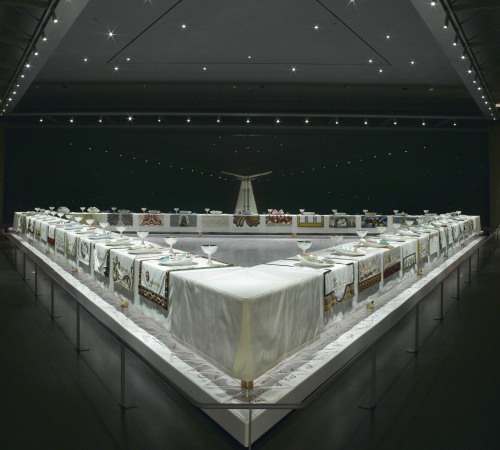
NEW YORK (AP) ― The Brooklyn Museum’s feminist art center is marking its fifth anniversary this year by commemorating famous women of the next millennium ― placing them alongside luminaries of the past.
The Elizabeth A. Sackler Center for Feminist Art is using Judy Chicago’s work, “The Dinner Party,’’ a massive triangular banquet table, to envision a place where these high achievers might meet.
Each wing of Chicago’s triangle pays tribute to a millennium ― 13 women for each ― beginning with primordial goddesses and ending with notable women in the 20th century; 999 other female names are inscribed in gold in the tiled floor.
The Sackler Center has created a symbolic fourth wing commemorating famous contemporary women who might be seated at the table alongside such influential women as Sacajawea, Queen Elizabeth I and Emily Dickinson.
It has selected 15 women, all first in their fields, who will be honored with the center’s first-time First Awards at a ceremony Wednesday.
They include Sandra Day O’Connor, the first woman to serve on the Supreme Court; Toni Morrison, the first African-American woman to receive the Noble Prize for literature; Muriel Siebert, the first woman to own a seat on the New York Stock Exchange; Connie Chung, the first person of Asian descent to hold a network anchor position; and Wilma Pearl Mankiller, the first female chief of the Cherokee Nation (she died in 2010.)
“The question I often get when giving tours of `The Dinner Party’ is `who would be there today, who would we add?’’’ said Catherine Morris, curator of the Sackler Center.
The goal of the First Awards is as ambitious as Chicago’s artwork, “equally as broad in our sweep looking for women whose contributions to their fields range from visual arts to other cultural arts, to politics, to education,’’ Morris said.
The honorees will be presented with a glass sculpture reminiscent of Chicago’s epic piece, decorated with chalices, table runners embroidered with the 39 names and ceramic plates with floral and butterfly designs as vulva symbols.
Chicago is a leading figure in feminist art whose imagery has sometimes stirred controversy. “The Dinner Party,’’ a collaborative work created between 1974-1979, fills a dramatic space at the museum with canted glass walls that is encircled by two galleries for changing exhibitions and a study center.
The 740 square-meter center is largely the vision of its benefactor, Elizabeth Sackler, whose goal was to raise awareness about feminist art.
“There is a serious underrepresentation of women and feminist artists in museums and galleries globally, said Sackler, a public historian and patron of the arts who donated “The Dinner Party’’ to the museum.
The Elizabeth A. Sackler Center for Feminist Art is using Judy Chicago’s work, “The Dinner Party,’’ a massive triangular banquet table, to envision a place where these high achievers might meet.
Each wing of Chicago’s triangle pays tribute to a millennium ― 13 women for each ― beginning with primordial goddesses and ending with notable women in the 20th century; 999 other female names are inscribed in gold in the tiled floor.
The Sackler Center has created a symbolic fourth wing commemorating famous contemporary women who might be seated at the table alongside such influential women as Sacajawea, Queen Elizabeth I and Emily Dickinson.
It has selected 15 women, all first in their fields, who will be honored with the center’s first-time First Awards at a ceremony Wednesday.
They include Sandra Day O’Connor, the first woman to serve on the Supreme Court; Toni Morrison, the first African-American woman to receive the Noble Prize for literature; Muriel Siebert, the first woman to own a seat on the New York Stock Exchange; Connie Chung, the first person of Asian descent to hold a network anchor position; and Wilma Pearl Mankiller, the first female chief of the Cherokee Nation (she died in 2010.)
“The question I often get when giving tours of `The Dinner Party’ is `who would be there today, who would we add?’’’ said Catherine Morris, curator of the Sackler Center.
The goal of the First Awards is as ambitious as Chicago’s artwork, “equally as broad in our sweep looking for women whose contributions to their fields range from visual arts to other cultural arts, to politics, to education,’’ Morris said.
The honorees will be presented with a glass sculpture reminiscent of Chicago’s epic piece, decorated with chalices, table runners embroidered with the 39 names and ceramic plates with floral and butterfly designs as vulva symbols.
Chicago is a leading figure in feminist art whose imagery has sometimes stirred controversy. “The Dinner Party,’’ a collaborative work created between 1974-1979, fills a dramatic space at the museum with canted glass walls that is encircled by two galleries for changing exhibitions and a study center.
The 740 square-meter center is largely the vision of its benefactor, Elizabeth Sackler, whose goal was to raise awareness about feminist art.
“There is a serious underrepresentation of women and feminist artists in museums and galleries globally, said Sackler, a public historian and patron of the arts who donated “The Dinner Party’’ to the museum.
-
Articles by Korea Herald











![[Today’s K-pop] BTS pop-up event to come to Seoul](http://res.heraldm.com/phpwas/restmb_idxmake.php?idx=644&simg=/content/image/2024/04/17/20240417050734_0.jpg&u=)






![[KH Explains] Hyundai's full hybrid edge to pay off amid slow transition to pure EVs](http://res.heraldm.com/phpwas/restmb_idxmake.php?idx=652&simg=/content/image/2024/04/18/20240418050645_0.jpg&u=20240419100350)

